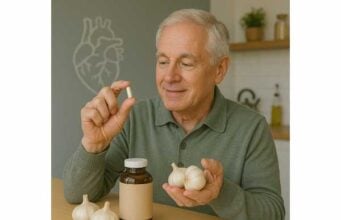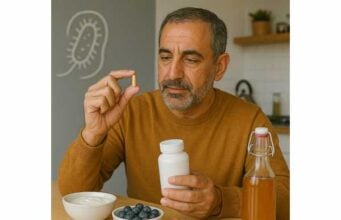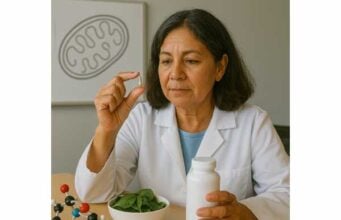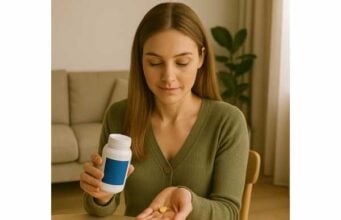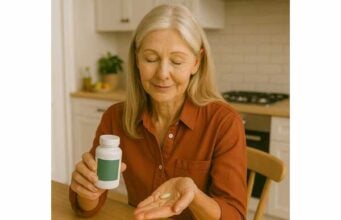Supplements
Home Supplements
Longevity Supplements and Nutraceuticals: Evidence and Safety
A longer healthspan depends on sleep, movement, food quality, relationships, and medical care. Still, many people ask whether supplements can add incremental gains. This guide surveys longevity-focused nutraceuticals through a practical lens: what they are, how they might work, where evidence is promising versus premature, and how to use them safely or not at all. You will find clear summaries, realistic effect sizes, and sensible next steps you can discuss with your clinician. For an integrated view of lifestyle, biomarkers, and interventions, explore our broader resource on evidence-based strategies for living longer and healthier. The goal here is not to chase trends, but to understand mechanisms, human data, and risk. We organize compounds by the outcomes people care about—energy, metabolic health, inflammation, cognition—and close with safety, dosing, and stack design so you can make measured, informed choices.Table of Contents
Read the complete Longevity Supplements Guide
What counts as longevity supplements?
“Longevity supplements” is a catch-all for nutraceuticals intended to support healthspan—years lived with good function—rather than simply extend lifespan. They target processes that tend to degrade with age: mitochondrial efficiency, metabolic flexibility, inflammation, proteostasis, vascular function, and cognitive resilience. The category spans vitamins and minerals (e.g., vitamin D, magnesium), bioactives from foods (e.g., sulforaphane from broccoli, polyphenols like resveratrol), conditionally essential nutrients (e.g., creatine, carnitine), and novel compounds (e.g., urolithin A, nicotinamide riboside). A useful way to define the space is by mechanism and evidence quality:- Energy and mitochondrial support: Coenzyme Q10, carnitine forms, PQQ, urolithin A, B-vitamins that enable oxidative phosphorylation.
- Metabolic health: Berberine, inositol, alpha-lipoic acid, magnesium; some fiber types for glycemic control.
- Cellular defense: Curcumin, sulforaphane, quercetin, hydroxytyrosol—compounds that activate antioxidant response elements (e.g., NRF2) or modulate inflammatory signaling.
- Senotherapeutics/autophagy promoters: Fisetin, spermidine, quercetin combinations, urolithin A; promise is emerging, human data vary by compound.
- Neurocognitive support: Creatine, phosphatidylserine, citicoline, lutein/zeaxanthin, omega-3 fatty acids.
- Vascular function: Beet nitrates, aged garlic, citrus bergamot, grape seed extract, omega-3s.
Do they work and how strong is the evidence?
The honest answer is: some do, for specific outcomes, in defined populations, and the magnitude of benefit is usually modest, not transformative. Evidence sits on a spectrum:- Consistent human data with plausible mechanisms. Examples include creatine for muscle strength and possibly cognition in older adults; omega-3s for triglycerides and some cardiovascular endpoints; nitrates from beetroot for blood pressure and exercise capacity; melatonin for sleep timing in circadian disorders.
- Promising but mixed RCTs, or benefits confined to subgroups. Berberine may lower fasting glucose and lipids in metabolic syndrome; aged garlic may support blood pressure; curcumin can reduce pain scores in osteoarthritis but varies with formulation.
- Mechanism-rich preclinical work and preliminary human trials. Urolithin A improves mitochondrial biomarkers and may enhance muscle endurance in mid-life and older adults; spermidine is tied to autophagy with observational hints for mortality reduction; fisetin shows senolytic activity in animals with early-stage human data.
- Prioritize outcomes that map to function (walking speed, VO₂ peak, grip strength, sleep latency) over isolated biomarkers.
- Look for dose-response and replication across independent groups.
- Favor trials in your demographic (e.g., ≥60 years, women in post-menopause, people with metabolic syndrome).
- Scrutinize formulations. Curcumin bioavailability differs by orders of magnitude; magnesium salts vary in GI tolerance and absorption; “NR vs NMN vs niacinamide” are not interchangeable.
- Balance benefit against plausible risk and cost. A safe, inexpensive compound with small consistent benefits may be a better bet than an expensive novel agent with early signals.
Mitochondria and cellular energy
Age-related declines in mitochondrial function reduce ATP output, increase reactive oxygen species, and impair muscle and brain performance. Several compounds target these nodes with complementary mechanisms.- Coenzyme Q10 (CoQ10). A lipid-soluble quinone essential for electron transport, CoQ10 supports ATP production and stabilizes mitochondrial membranes. Supplementation is most compelling when endogenous levels are low: older age, statin use, heart failure, and possibly migraine. Ubiquinone and ubiquinol are interconvertible; bioavailability depends more on the delivery system than the redox state. Typical intakes range from 100–300 mg/day with fat-containing meals. People on warfarin should consult clinicians due to potential interactions. For use cases, forms, and dosing nuances, see CoQ10 for longevity.
- Carnitine family. Carnitine shuttles long-chain fatty acids into mitochondria for β-oxidation. Acetyl-L-carnitine (ALCAR) crosses the blood–brain barrier and may support cognitive function and neuropathic discomfort; L-carnitine tartrate appears in exercise and recovery contexts. Doses span 1–2 g/day divided, titrated to GI tolerance.
- Urolithin A. A gut-derived metabolite of ellagitannins (from pomegranates and some nuts), urolithin A activates mitophagy—the selective recycling of damaged mitochondria—potentially improving muscle endurance and cellular energy. Human trials report improved 6-minute walk distance, leg endurance, and mitochondrial gene expression after several months. Typical supplemental intakes in studies are ~500–1000 mg/day. Learn more in our guide to urolithin A.
- Pyrroloquinoline quinone (PQQ). PQQ may promote mitochondrial biogenesis through PGC-1α signaling and support redox balance. Early human data suggest benefits for fatigue and cognitive markers; dosing commonly ranges 10–20 mg/day.
Metabolic and insulin sensitivity
Metabolic flexibility—your ability to switch between carbohydrate and fat as fuel—declines with age. Insulin resistance, visceral adiposity, and dyslipidemia drive vascular and cognitive risk. Supplements are not substitutes for calorie control, protein adequacy, fiber, and activity, but several agents can amplify lifestyle gains.- Berberine. An isoquinoline alkaloid that activates AMPK, berberine modestly lowers fasting glucose, HbA1c, and triglycerides in people with type 2 diabetes or metabolic syndrome. It may also improve gut microbiota composition. Typical dosing is 500 mg two to three times daily with meals; GI side effects (bloating, constipation, loose stools) are the main limitation. Avoid during pregnancy and lactation, and check for drug interactions (notably cyclosporine and some CYP substrates). See our practical overview of berberine.
- Alpha-lipoic acid (ALA). ALA is a mitochondrial cofactor with antioxidant properties and may improve insulin sensitivity and neuropathic symptoms. R-ALA is the naturally occurring isomer; both R-ALA and racemic ALA appear in studies (300–600 mg/day). It can lower blood sugar—monitor if you use glucose-lowering medications. More in our ALA guide.
- Inositol (myo- and D-chiro-). Inositols serve as insulin second messengers. Evidence is strongest for women with polycystic ovary syndrome (PCOS), but older adults with metabolic syndrome may also see improved fasting insulin and lipids. Doses often total 2–4 g/day, sometimes in a 40:1 myo:D-chiro blend.
- Magnesium. Low magnesium is common and associated with insulin resistance and elevated blood pressure. Supplemental magnesium (200–400 mg elemental/day) can improve glycemic control and sleep quality in those who are deficient. Glycinate and citrate salts tend to be gentler on the gut; oxide is poorly absorbed.
Inflammation and cellular defense
Inflammaging—chronic, low-grade inflammation that rises with age—drives vascular damage, sarcopenia, and neurodegeneration. Equally important is cellular defense capacity, the ability to induce antioxidant and detoxification enzymes when needed. Several compounds modulate these axes.- Curcumin. The principal curcuminoid in turmeric inhibits NF-κB and COX-2 signaling and may reduce pain and inflammatory markers. Bioavailability varies dramatically; look for phytosomal or piperine-enhanced forms used in clinical trials. Doses range from 500–1000 mg/day of standardized extract. GI upset is the most common side effect; curcumin may interact with anticoagulants. See specifics in our curcumin review.
- Sulforaphane. Generated from glucoraphanin in broccoli sprouts via myrosinase, sulforaphane induces NRF2, upregulating phase II enzymes that help neutralize oxidants and pollutants. Human studies suggest benefits for glucose control, airway inflammation, and detoxification of airborne toxins. Because sulforaphane is unstable, look for preparations providing active sulforaphane or kits that combine glucoraphanin with active myrosinase. Typical intakes supply 20–40 mg sulforaphane equivalents, several days per week. We detail options in our sulforaphane guide.
- Quercetin and pterostilbene/resveratrol. These polyphenols modulate inflammatory and sirtuin pathways. Their direct antioxidant action is less relevant than cell-signaling effects. Evidence for hard endpoints remains mixed; benefits may include endothelial function and inflammatory markers. Quercetin can trigger headaches or tingling in some users; resveratrol may interact with anticoagulants.
- Hydroxytyrosol and olive polyphenols. Central to Mediterranean dietary benefits, they support LDL resistance to oxidation and endothelial health.
- Adults with osteoarthritis pain not controlled by NSAIDs alone may respond to curcumin.
- Those with high environmental exposures or allergic airway issues may find sulforaphane useful as an adjunct.
- Individuals with borderline endothelial function (e.g., hypertension, metabolic syndrome) might trial polyphenols alongside lifestyle changes.
Brain and cognitive aging
Cognitive aging is multifactorial: synaptic loss, vascular injury, sleep fragmentation, neuroinflammation, and metabolic drift all contribute. While no supplement prevents dementia, several interventions may support memory, processing speed, and mental energy—especially when combined with sleep optimization, resistance training, and social engagement.- Creatine. Best known for muscle, creatine also fuels the phosphocreatine shuttle in neurons and glia. Supplementation (3–5 g/day) can improve short-term memory and reasoning in sleep-deprived or older adults in some trials, and it consistently enhances muscle strength—an indirect win for brain health via increased activity and fall prevention. People with chronic kidney disease should review creatine with their clinician, and everyone should drink adequate fluids. See contexts and dosing in our creatine guide.
- Phosphatidylserine (PS). A phospholipid concentrated in neuronal membranes, PS may aid memory, attention, and stress response in older adults with subjective cognitive decline. Typical dosing is 100 mg, three times daily (total 300 mg/day) for several months; some products combine PS with phosphatidic acid or omega-3s. People on anticoagulants should confirm safety. Learn more in our PS overview.
- Choline and citicoline (CDP-choline). Choline is a precursor to acetylcholine and phosphatidylcholine. Citicoline may support attention and memory, with doses around 250–500 mg/day. Those with diets low in eggs or who carry PEMT variants may be more responsive.
- Lutein and zeaxanthin. Carotenoids that accumulate in the macula and brain, they support visual processing and may aid cognition in older adults. Typical intakes are 10 mg lutein plus 2 mg zeaxanthin daily.
Senolytics and autophagy
Cellular senescence is a program in which damaged cells stop dividing yet remain metabolically active, secreting inflammatory factors that impair tissue function. With age, these “zombie” cells accumulate. Senolytics aim to selectively clear them; autophagy promoters aim to recycle cellular components, including mitochondria (mitophagy). While animal data are compelling, human trials are still early, heterogeneous, and often small. A measured approach focuses on candidates with plausible mechanisms and emerging safety profiles. Fisetin is a plant flavonol that triggers apoptosis in senescent cells in preclinical models. It appears to act on BCL-2 family and PI3K/AKT signaling. Pilot human studies and protocols use intermittent, high-dose regimens (e.g., 20 mg/kg/day for 2 days per month), though optimal dosing is unsettled and may depend on body mass, liver function, and concurrent medications. Practical, lower-intensity approaches prioritize cycles separated by weeks, with attention to liver enzymes and symptom tracking (fatigue, headaches, GI upset). For an implementation-focused overview, see our guide to fisetin in healthy aging. Spermidine is a polyamine found in wheat germ, soy, mushrooms, and aged cheese. It induces autophagy through acetyltransferase inhibition and eIF5A hypusination pathways. Observational research links higher dietary intake to lower mortality; small randomized trials report improvements in memory performance in older adults with subjective decline. Typical supplemental intakes are 1–2 mg/day from wheat-germ–derived extracts. Monitor for GI sensitivity in those with FODMAP intolerance. We detail food sources, dosing pragmatics, and trial readouts in our spermidine review. Quercetin combinations are sometimes positioned as senolytic, often with dasatinib in research settings. Because dasatinib is a prescription tyrosine kinase inhibitor with meaningful risks, non-prescription users should not self-experiment with this combination. Quercetin alone is better framed as a senomodulator—altering the senescence-associated secretory phenotype (SASP)—rather than a classic senolytic. Those seeking a gentler approach sometimes cycle quercetin for 2–4 weeks, pause, and reassess joint comfort or skin quality. People prone to headaches or tingling should stop and review dosing. Urolithin A belongs in this conversation because it upregulates mitophagy, facilitating the removal of dysfunctional mitochondria. In middle-aged and older adults, supplementation has improved muscle endurance and mitochondrial biomarkers over months of use. If you respond with better stamina and less perceived effort during daily climbs, continue; otherwise, discontinue after a well-run 12–16 week trial. How to evaluate these tools:- Pick one axis (senolytic cycles, spermidine, or urolithin A) to trial first. Avoid layering multiple “cell clearance” approaches simultaneously.
- Use functional endpoints: loaded carry distance, chair-stands in 30 seconds, 6-minute walk, or an incline treadmill test. Repeat under similar conditions every 4–6 weeks.
- Keep cycles finite: run two to three cycles, then pause. Senescence also serves wound-healing and anti-cancer roles; indiscriminate suppression is unwise.
- Add foundational autophagy inducers—fasted morning walks, protein-balanced time-restricted eating if appropriate, and sleep optimization—before escalating dose or complexity.
Vascular and heart health
Arterial stiffness, endothelial dysfunction, and a shift toward small, dense LDL particles raise risk as we age. Blood pressure, triglycerides, and inflammatory tone are the modifiable levers most people can influence. Several nutraceuticals have human data for these endpoints, particularly when paired with walking, resistance training, sodium control, fiber, and weight management. Dietary nitrates (beetroot). Nitrates convert to nitric oxide, supporting vasodilation and exercise efficiency. Standardized beetroot juice or nitrate capsules can reduce resting blood pressure modestly and improve time-to-exhaustion and submaximal exercise performance in older adults. Practical dosing: 300–500 mg nitrate equivalents (often ~500 ml beetroot juice or concentrated “shots”), 2–3 hours before activity. Those with hypotension or on PDE-5 inhibitors should use caution and discuss with a clinician. For formulations and use cases, see our nitrate guide. Citrus bergamot. Extracts standardized to bergamot polyphenolic fraction (BPF) may reduce LDL-C and triglycerides in people with mixed dyslipidemia, potentially by upregulating LDL receptors and inhibiting HMG-CoA reductase. Doses range from 500–1000 mg/day. Some users experience heartburn or GI discomfort. Integration with statins should be clinician-directed to avoid overshooting LDL or unexpected interactions. We dive deeper in our bergamot overview. Other options include aged garlic extract (mild reductions in blood pressure and CAC progression signals) and grape seed extract (OPC-rich formulas that can improve capillary integrity and modestly lower blood pressure). Meanwhile, omega-3s (EPA/DHA) reliably lower triglycerides and, at sufficient doses, have shown cardiovascular risk reduction in meta-analyses, with atrial fibrillation risk rising at higher intakes; people with palpitations should discuss dosing and monitoring. How to combine wisely:- If triglycerides are ≥150 mg/dL, prioritize omega-3s and weight loss if appropriate; if LDL-C is elevated but statin-intolerant, discuss adding citrus bergamot with your clinician.
- For exercise tolerance and everyday stamina, trial beet nitrates before walking, cycling, or rehab sessions.
- Consider aged garlic to complement blood pressure programs focused on sodium reduction, potassium adequacy, and activity.
- Track home blood pressure (AM/PM averages, seated), aiming for values individualized by your clinician.
- Recheck lipids 8–12 weeks after any change; track non-HDL-C and apoB when accessible.
- If using high-dose omega-3s, ask about arrhythmia monitoring in those with a history of atrial fibrillation.
- Strength train 2–3 times weekly to improve vascular compliance and insulin sensitivity.
- Accumulate 7,000–9,000 steps/day with short post-meal walks to blunt glucose spikes.
- Eat 30–40 g/day of viscous fibers (oats, legumes, psyllium) and make extra-virgin olive oil your default fat.
Hormones and circadian
Hormonal drift with age—lower melatonin and growth hormone, altered cortisol patterns, declining sex steroids—interacts with circadian disruption to erode sleep, muscle, and mood. Nutraceuticals cannot replace individualized endocrine care, but a few options are useful adjuncts. Melatonin supports circadian timing, especially when endogenous production wanes. For sleep onset issues and advanced age, 0.3–1 mg taken 60–90 minutes before target bedtime often suffices; some individuals benefit from 2–3 mg. For jet lag or delayed sleep phase, timing relative to local bedtime is crucial. Combine with: bright morning light, evening dim light, consistent wake times, and a cool, dark bedroom. We cover dosing nuances and formulations (immediate vs controlled release) in our melatonin guide. DHEA is an adrenal prohormone that declines with age. In select contexts—adrenal insufficiency, some postmenopausal symptoms—low-dose DHEA may help with wellbeing or sexual function. It can also convert to androgens and estrogens, which is why lab monitoring (DHEA-S, estradiol/testosterone) and clinical oversight are mandatory. Overuse can cause acne, hair changes, mood shifts, or lipid perturbations. See background and cautions in our DHEA overview. Magnesium (200–400 mg elemental/day) supports sleep quality and muscle relaxation, especially if intake is low. Glycinate and threonate salts are well tolerated; oxide is poorly absorbed and more laxative. Glycine (3 g at bedtime) can lower core body temperature and shorten sleep latency for some. L-theanine (100–200 mg) may blunt pre-sleep rumination without next-day sedation. Thyroid and iodine: In iodine-replete regions, additional iodine seldom helps and can worsen autoimmune thyroiditis at high doses. Selenium (100–200 mcg/day) may benefit certain thyroid antibody patterns but has a narrow safety margin; food sources (Brazil nuts in measured amounts) are safer than stacking multiple selenium-containing products. Cortisol rhythm: Chronic late-night work, inconsistent meals, and alcohol close to bedtime flatten cortisol rhythms. Start with behavioral scaffolding—time-restricted eating that ends 3–4 hours before bed, afternoon caffeine cutoffs, alcohol restraint—and add supplements only if needed. Phosphatidylserine (300 mg in the evening) can reduce stress reactivity; ashwagandha shows modest effects on perceived stress, with potential thyroid interactions—choose standardized, third-party tested extracts and reassess in 6–8 weeks. Who should be cautious:- Anyone with bipolar spectrum or severe depression should consult a clinician before using melatonin, DHEA, or adaptogens.
- People with hormone-sensitive cancers should avoid DHEA and discuss phytoactives with their oncology team.
- Those on anticoagulants should review supplement plans for interactions.
Gut microbiome and aging
The gut microbiome shifts with age: reduced diversity, fewer butyrate producers, more pro-inflammatory taxa. These changes can influence immunity, glucose control, and even sarcopenia via microbial metabolites. While microbiome science evolves quickly, several low-risk, high-upside strategies stand out. Prebiotics and fiber diversity. Aim for 30+ different plant foods per week, favoring legumes, oats, barley, onions, leeks, garlic, and brassicas. Specific prebiotic fibers—inulin, FOS, GOS, resistant starch—feed beneficial microbes and boost butyrate, which tightens gut barriers and calms inflammation. Doses: inulin or FOS 3–10 g/day (titrate slowly); resistant starch 10–20 g/day. We detail options and how to ramp without bloating in our prebiotics and postbiotics guide. Probiotics by function, not hype. Choose strains tied to outcomes you care about: Bifidobacterium longum 35624 for abdominal discomfort, Lactobacillus rhamnosus GG for antibiotic-associated diarrhea risk, B. lactis HN019 for transit time, L. plantarum strains for gas/bloating. Multi-strain blends can be useful, but more is not always better—strain identity and CFUs at end of shelf life matter. For a practical selection framework, see our probiotics guide. Akkermansia is a mucin-degrading genus linked to metabolic and gut barrier health. Levels often decline with age and in metabolic syndrome. While Akkermansia muciniphila supplements exist, much of the benefit likely comes from feeding this microbe with polyphenols (cranberries, pomegranates) and prebiotic fibers. Pasteurized Akkermansia shows promise for insulin sensitivity and liver fat in early trials; long-term aging outcomes remain unknown. We outline what supplementation can and cannot do in our Akkermansia deep-dive. Polyphenols as microbiome modulators. Green tea catechins (EGCG), cocoa flavanols, and pomegranate ellagitannins foster beneficial species and produce metabolites (e.g., urolithins) with systemic effects. Food-first sources are preferred; supplements can be layered for targeted goals like endothelial function or post-meal glucose. Protein and digestion. Older adults need 1.0–1.2 g/kg/day of protein to preserve muscle; this can stress digestion when fiber is low. Use digestive pacing: chew thoroughly, distribute protein across 3–4 meals, include bitter greens and ginger to stimulate gastric secretions, and walk 10 minutes after meals. When to test: Consider stool testing if you have persistent GI symptoms, antibiotic exposure with incomplete recovery, or inflammatory bowel disease. Testing can be helpful to rule out pathogens and to quantify calprotectin, but commercial “dysbiosis scores” vary in quality and clinical relevance. Cautions:- Rapid fiber increases can worsen bloating; titrate 2–3 g/week.
- Probiotic side effects (gas, loose stools) usually settle within 7–10 days; if not, switch strain or reduce dose.
- Immunocompromised individuals should use clinician-guided probiotic strategies.
Safety, dosing, and quality
Because supplements are potent enough to help, they are also potent enough to harm—or to waste time and money if poorly chosen. A structured approach improves outcomes. 1) Clarify goals and metrics. Choose one or two top outcomes (e.g., resting BP, 6-minute walk distance, sleep latency, fasting glucose) and define success thresholds (e.g., −5 mmHg average BP over 8 weeks). 2) Start low, go slow, and avoid stacks-on-stacks. Introduce one change at a time for 4–12 weeks. Keep a simple log: dose, timing, adherence, and the metric you care about. Discontinue non-responders. 3) Dose and form matter.- Magnesium: use glycinate, citrate, malate for 200–400 mg elemental/day; avoid high-dose oxide unless you need a laxative effect. See our magnesium primer for details.
- Vitamin D and K2: pair D3 with meals containing fat, recheck 25(OH)D after 8–12 weeks, and consider K2 (MK-7) when supplementing D3 for long periods, especially in those at risk for low K intake. We cover ranges and caveats in our D and K2 overview.
- Anticoagulants/antiplatelets: curcumin, resveratrol, fish oil, aged garlic can affect bleeding risk.
- Antihypertensives: beet nitrates, aged garlic, magnesium can compound effects.
- Glucose-lowering meds: berberine and ALA may potentiate hypoglycemia.
- Thyroid meds: calcium, iron, magnesium, and high-fiber blends can impair absorption—separate by at least 4 hours.
- Baseline and 8–12 weeks: lipids, fasting glucose/HbA1c (if metabolic goals), 25(OH)D (if supplementing), magnesium if indicated, and blood pressure logs.
- Every 6–12 months: liver enzymes if using polyphenol concentrates at high doses, kidney function if using creatine or high-protein diets and you have preexisting CKD risk.
- Pregnant or lactating: avoid berberine, high-dose polyphenols, and any senolytic strategies.
- Kidney disease: review creatine, magnesium, potassium-containing products with your nephrologist.
- Autoimmune conditions: introduce immune-active botanicals cautiously and one at a time.
Practical stacks and budgets
You do not need a dozen products to support healthy aging. Below are tiered, goal-based stacks that respect budget and attention. Each stack assumes baseline habits: 7–8 hours in bed, two days of strength training, daily walking, 90–120 g of protein (adjusted to body size), and 30–40 g of fiber. A) Conservative core (most people, modest budget)- Magnesium glycinate (200–300 mg elemental in the evening): sleep quality, muscle relaxation. See our magnesium guide.
- Omega-3s (combined EPA/DHA providing ~1 g/day with meals): triglycerides and vascular support; consider EPA-only under clinician guidance if high ASCVD risk, with attention to atrial fibrillation history. We outline dose and index targets in our omega-3 overview.
- Creatine monohydrate (3–5 g/day): muscle strength and potential cognitive support, especially in older adults.
- Vitamin D3 (1,000–2,000 IU/day, individualized to labs) ± K2 (MK-7) for long-term D support.
- CoQ10 (100–200 mg/day with fat) if on statins or with fatigue.
- Urolithin A (500–1000 mg/day) for 12–16 weeks; continue only if endurance improves.
- Beet nitrates before training/rehab days to enhance session quality.
- Berberine (500 mg with meals, 2–3×/day) for 8–12 weeks; monitor GI tolerance and fasting glucose/HbA1c.
- Inositol (2–4 g/day) if insulin resistance persists or for specific contexts like PCOS.
- Fiber blend (psyllium/oat β-glucans/inulin) to hit 30–40 g/day total fiber with meals.
- Curcumin phytosome (500–1000 mg/day) for 8–12 weeks; assess pain/function scales.
- Hydroxytyrosol/olive polyphenols (as part of using extra-virgin olive oil generously) or grape seed extract for endothelial tone.
- Creatine (3–5 g/day) plus citicoline (250–500 mg/day) or phosphatidylserine (300 mg/day) to support attention and memory.
- Lutein/zeaxanthin (10/2 mg/day) for visual-cognitive processing, especially with screen-heavy work.
- Spermidine (1–2 mg/day) from standardized extracts or food sources, reassessed at 12 weeks.
- Periodic fiber “fasting-mimetic” days: higher-fiber, lower-calorie meals emphasizing legumes, crucifers, and polyphenol-rich berries; light activity.
- Spend first on protein, produce, and training. Supplements amplify, not replace, these levers.
- Fund labs (lipids, omega-3 index if available, 25(OH)D, HbA1c) before adding niche products.
- Prefer single-ingredient products at evidence-based doses over under-dosed blends.
- Introduce one item at a time, spaced 4–8 weeks apart.
- Keep a weekly two-line note: “What changed? Is it worth the cost?”
- Cycle off non-essentials every few months to confirm ongoing value.
References
- Effect of Urolithin A Supplementation on Muscle Endurance and Mitochondrial Health in Older Adults: A Randomized Clinical Trial (2022).
- Glucose-lowering effect of berberine on type 2 diabetes: A systematic review and meta-analysis (2022).
- Effect of omega-3 fatty acids on cardiovascular outcomes: A systematic review and meta-analysis (2021).
- Effect of melatonin supplementation on sleep quality: a systematic review and meta-analysis of randomized controlled trials (2021).
- Effects of creatine supplementation on memory in healthy individuals: a systematic review and meta-analysis of randomized controlled trials (2023).


